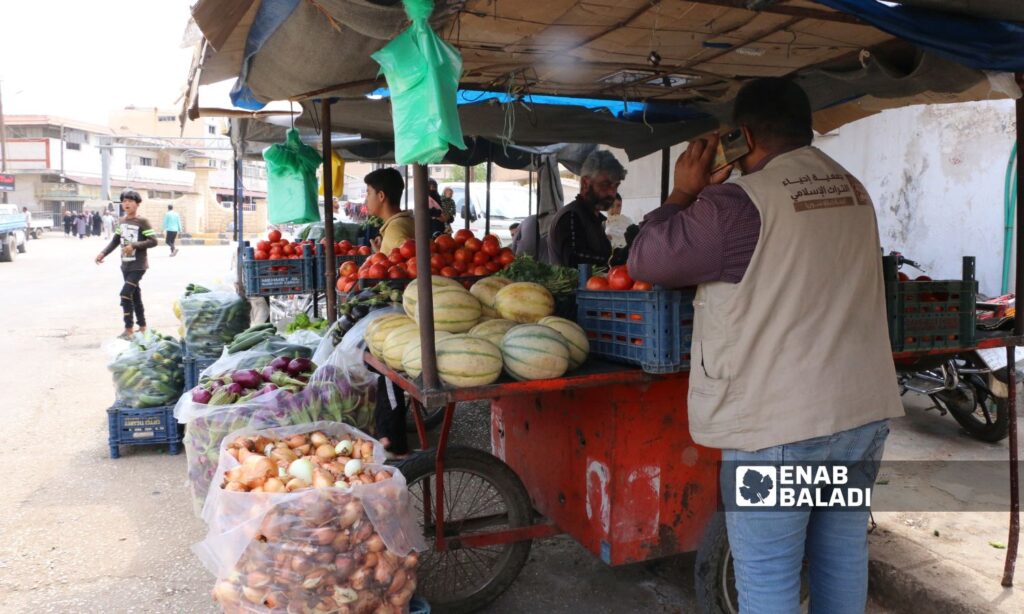Enab Baladi – Ras al-Ain
The market in Ras al-Ain, northwest of al-Hasakah, has seen a significant decline in vegetable prices over the past weeks due to several factors, the most important being the abundance of supply and the peak of the summer production season.
This reduction has alleviated the financial burdens on the approximately 115,000 residents, especially with the rising prices of other food items.
According to an Enab Baladi correspondent’s tour in the Ras al-Ain market this July, vegetable prices have decreased by twice as much or more compared to early June. Meanwhile, potato prices have remained unchanged at 6,000 Syrian pounds per kilogram (one dollar equals 15,000 pounds) due to them not being grown in the region.
Reasonable prices
As summer approaches, locals plant vegetable crops to meet their needs, with some dedicating part of their land to growing vegetables for sale.
Ras al-Ain is well-known for the production of local vegetables by the Sfarneh people from the al-Safira area in Aleppo, who sell in the market, leading to significant price drops.
Malek al-Azooz, a resident of Ras al-Ain, told Enab Baladi that the decrease in vegetable prices now aligns with his monthly income of no more than 1.2 million Syrian pounds. He added that he could now buy larger quantities for his household and store them regularly.
Faisal al-Hassan from Tal Half town stated that he used to search for medium-quality vegetables due to their high prices a few months ago, buying no more than a kilogram.
For instance, he said, 18,000 Syrian pounds used to buy one kilogram of tomatoes, but now the same amount buys six kilograms.
He added to Enab Baladi that he used to spend 50,000 pounds daily on vegetables, but now he spends no more than 15,000 pounds a day for high-quality vegetables.
Al-Hassan also called for supporting these crops from relevant authorities, as they reduce financial burdens on residents and meet a significant portion of their daily needs.
Due to the drop in vegetable prices, there has been a noticeable increase in sales in Ras al-Ain markets, where shopkeepers and vendors have achieved substantial profits due to increased demand.
Motasem al-Hamran, a vegetable vendor in Ras al-Ain, said his daily sales were no more than 30 kilograms of vegetables two months ago; currently, his average sales exceed 150 kilograms daily, allowing him a higher profit margin.
Supply meets residents’ needs
Omar Hamood, head of the Agriculture Bureau in the local council, told Enab Baladi that vegetables are abundant in Ras al-Ain due to residents cultivating their lands with areas ranging from one to five dunams per farmer.
Hamood explained that cultivating summer vegetables is not new to Ras al-Ain, where more than 80% of farmers grow vegetables in their lands during the summer.
He added that a large portion of residents relies on summer vegetable cultivation as a livelihood source, selling in local markets at reasonable prices while making a modest profit.
He pointed out that the directorate has provided farmers with agricultural consultations and plowing services at nominal costs to improve and develop these crops in the region.
Besides, agriculture and livestock breeding are the main professions for most residents of Ras al-Ain, forming a primary source of income.
Ras al-Ain and Tal Abyad are located close to the Turkish border, controlled by the Turkish-backed Syrian National Army (SNA), surrounded by fronts with the Syrian Democratic Forces (SDF), and the Turkish border serves as their only outlet to the outside world.











